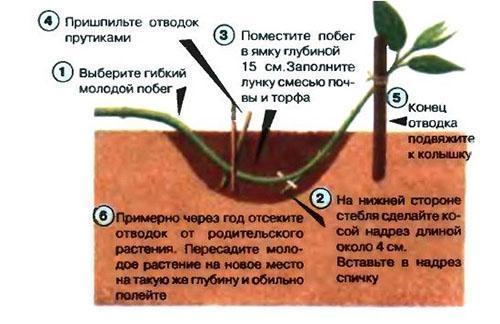Spirea propagation by layering and its spring pruning
 Spirea is a tenacious shrub. This plant can take root even in heavy clay soil. It is very easy to care for the plant, the main thing is to maintain a constant soil moisture at 60%.
Spirea is a tenacious shrub. This plant can take root even in heavy clay soil. It is very easy to care for the plant, the main thing is to maintain a constant soil moisture at 60%.
Only the summer-flowering subspecies of spirea can withstand spring pruning, for example, the Japanese spirea variety. If shrubs are formed in the spring with a spring flowering period, then they will not form flower buds.
Reproduction of spirea by layering
During spring pruning, it can be propagated with spirea by layering, but the bush must be adult and healthy. Layers are formed from four-year-old basal shoots. In order for the branches to take root, nitrogen and complex mineral fertilizers are applied to the soil. As a nitrogen-containing fertilizer, you can use herbal infusion or rotted cow dung.
After fertilizing the soil, you must:
- make a hole in the ground 10-15 cm deep;
- spill the well with a hot, slightly pink solution of potassium permanganate;
- lower the root shoot into the moistened soil and cover the hole with earth.
It is desirable that the shoot that you are going to root has from four vegetative buds. It is from them that the first roots will appear. A buried shoot needs frequent watering and fertilizing, therefore, in the summer, once a week, growth stimulants are introduced into the soil, and in the spring - potassium-containing fertilizers.
Two months after the formation of the layer, it will take root and hatch from the soil, and a year later - a full-fledged seedling will grow. In the spring, it can be separated from the mother plant and transplanted into a pot so that the spirea forms a closed root system. Then the seedling is transplanted to a permanent place.
Trimming the spirea
Summer blooming Spirea varieties need to be shaped. First of all, cut off all diseased and dried branches. Thin basal shoots are also completely removed. On a four-year-old bush, up to five skeletal branches are left. Thick shoots are shortened. If last year's strong branch has formed weak growths, it is completely removed.
For easy pruning, you can use a garden pruner. Do not be afraid to remove the shoots of the bush, as after pruning the spirea will quickly recover. The plant forms flower buds on young growths this year, so a strong pruning will only benefit the spirea. In order to get the maximum number of flower buds, old shoots must be shortened to 20 cm above the soil level, and last year's shoots must be pinched.